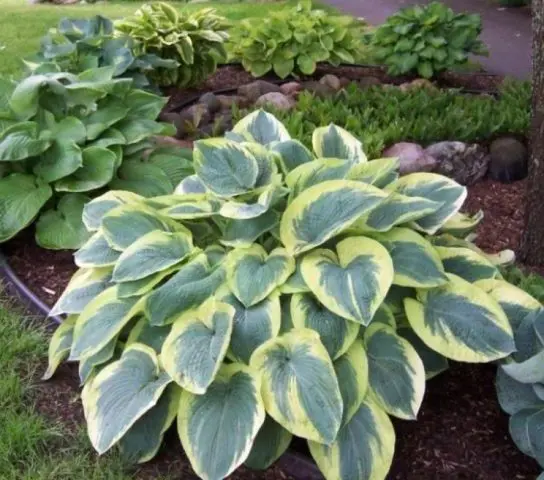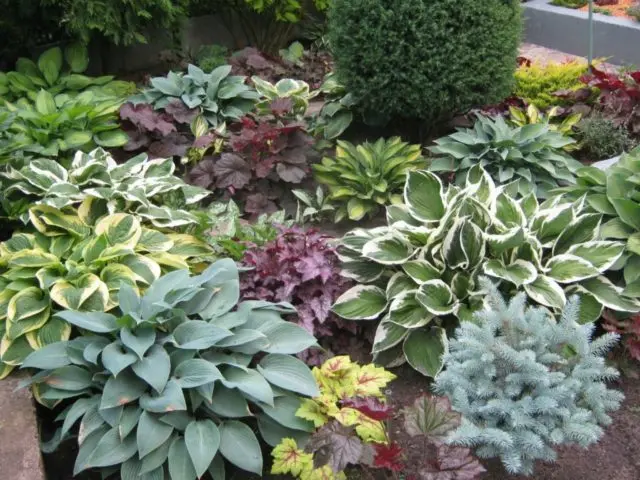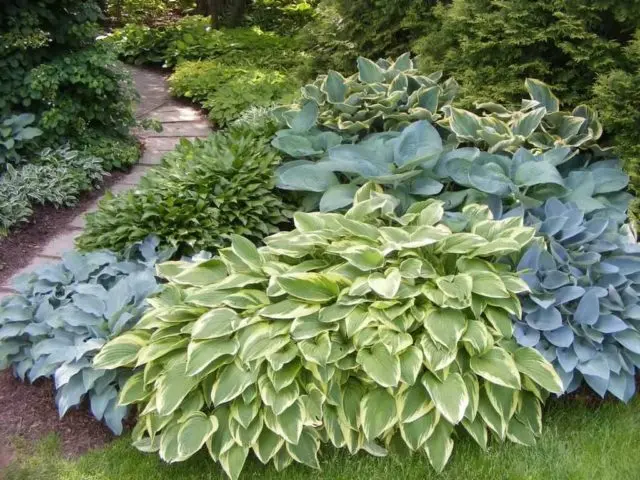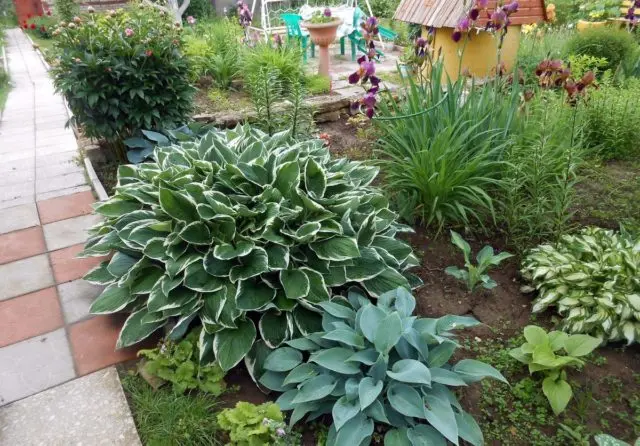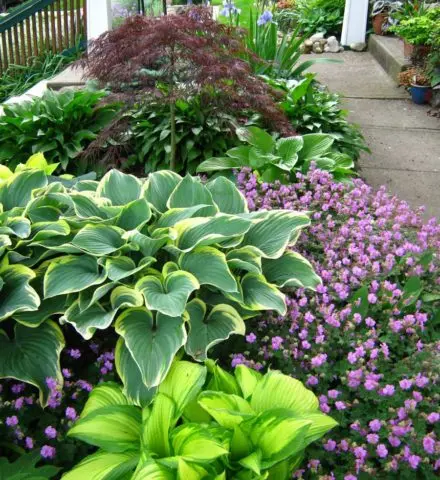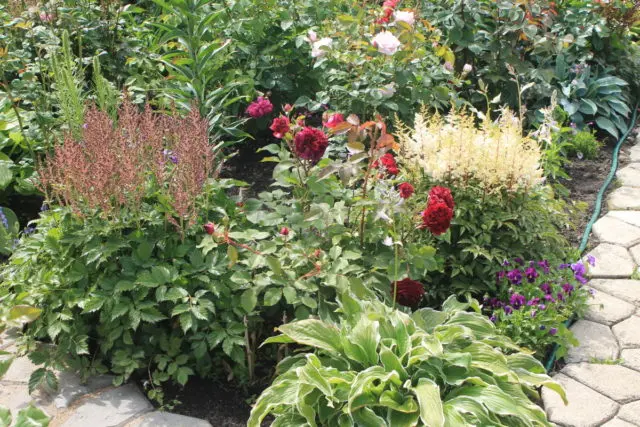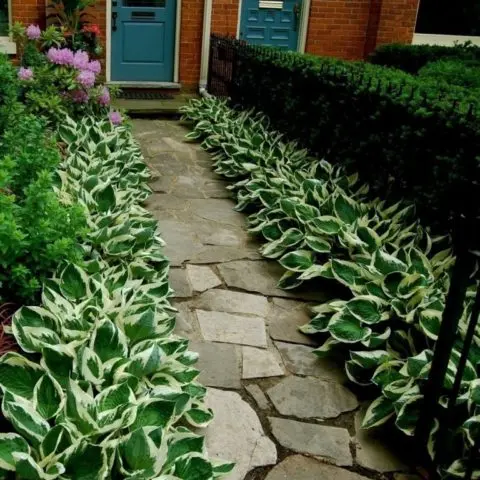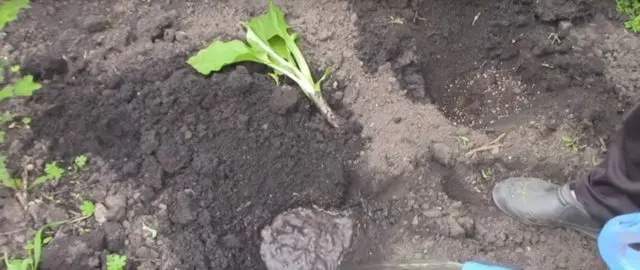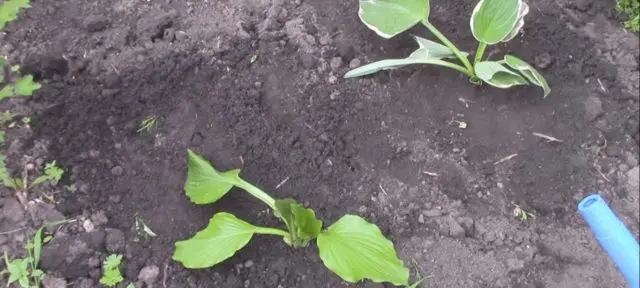Contents
Hosta is a perennial plant that can grow in one place for more than 15 years. The culture is represented by numerous hybrid forms with different sizes and leaf colors. Hosta American Halo is a tall representative, one of the sought-after varieties for landscape designers and gardeners.
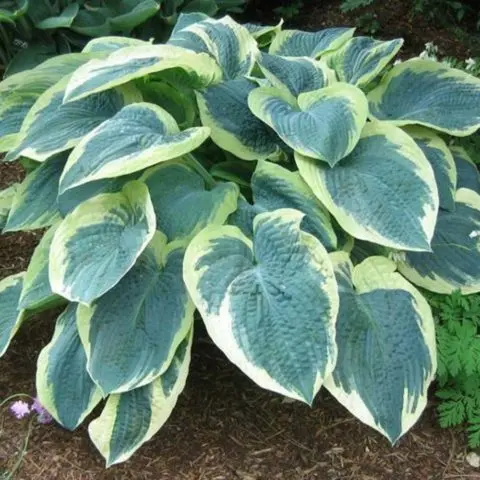
Spreading hosta crowds out nearby herbaceous crops
Description Hosted by American Halo
The varietal name American Halo, which means halo (radiance), was received by the host due to the unusual color of the habit, which remains unchanged throughout the growing season. The Dutch hybrid was created specifically for ornamental gardening in cold climates. The frost resistance of the plant is in the range of -35-40 0C.
A variety of American Halo is often found in the gardens of the Moscow region, they grow a crop in the European part, the Middle Strip, Siberia, the North Caucasus, and the Far East. Khosta is an integral element of the design of the resort area of the Black Sea coast. A heat-loving plant feels equally comfortable in subtropical and temperate continental climates.
American Halo grows rapidly, in the second growing season, the structure and color of the leaves are fully manifested, for which the plant is valued. The end point of growth, declared in the varietal characteristic, is reached by the host in the third year after planting.
Characteristics of the hybrid American Halo:
- The shape of the host is dome-shaped, sprawling, dense, height and width – 80 cm.
- Numerous leaves are formed from a basal rosette, located on long thick petioles.
- Leaf plates are broadly ovate, with a sharp apex, thick with a rigid structure, smooth edges, length – 30-35 cm, diameter 25-28 cm.
- The surface is corrugated, the central part is painted in light green with a pronounced blue tint, the frame is white or beige. Hosta American Halo is a variegated variety.
- The root system is superficial, highly branched, fibrous, the basal circle is about 50 cm.
- The flowering period is 25-28 days, falls on June-July.
- Hosta forms 4-6 erect peduncles up to 1 m high.
- Racemes are located in the upper part. They consist of drooping bell-shaped flowers, 6-cut, light purple.

The color of the flowers depends on the lighting, in the shade they appear brighter.
Variegated forms do not tolerate prolonged exposure to the sun. Light stripes along the edge of the leaf plate burn. American Halo is a shade-tolerant representative of the culture, its decorative effect is completely dependent on lighting.
Application in landscape design
Decorative hosta American Halo is appropriate in any composition. It is planted near water bodies, in the shade of large-sized plants. The plant is universal in terms of design: it is combined with almost all types of flowering and ornamental shrubs, ground cover, dwarf forms of conifers. In combination with a host, mixborders are created with tall and creeping flowering plants:
- irises;
- peonies;
- roses;
- tulips;
- astilba;
- primrose;
- rhododendron.
Hosta is planted at the foot of thuja, blue firs as a padding. Often use mass planting of crop varieties with different leaf colors. Any flowering herbaceous plant is allowed to be adjacent to American Halo, as long as the culture does not obscure or displace it from the site.
Several application options:
- designation of the perimeter of the flower beds;

- creating a mixborder with brightly colored seedlings;

- zonal division of the site;

- as a corner of wildlife in the garden;

Hostas are ideally combined with natural stone
- for tamping tall shrubs and trees;

The plant not only feels comfortable in the shade, but also decorates the root area.
- for the design of a recreation area;

Irises, peonies and hostas complement each other favorably
- grown as a central accent;

- to fill the empty space along the edges of the rose garden;

- create border compositions;

Often use culture as a tapeworm in rockeries and rock gardens. Include in a group planting for gardens in the Japanese style.
Breeding methods
American Halo is a hybrid variety that produces seeds in late summer. When propagating in a generative way, a loss of decorative qualities is possible. It is better to purchase seedlings in a specialized store, and after three years of growth, propagate them with root rosettes.
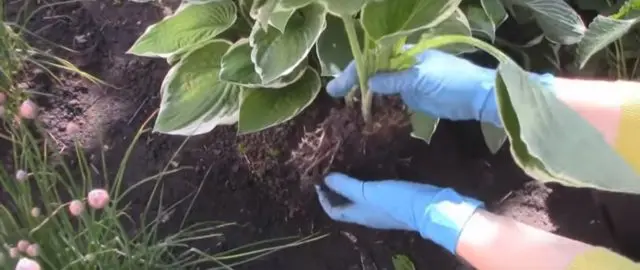
You do not need to dig out the bush completely; with a knife, cut out an area with one rosette of leaves
Landing algorithm
Hostas are planted in the spring, when the green mass has taken shape to separate from the mother bush. The plot under the American Halo is assigned in the shade or with periodic shading. The plant does not tolerate a waterlogged root ball; places in a lowland or with close groundwater are not suitable. The soil should be neutral, aerated, fertile.
If the material is purchased, it is placed on a plot with an earthen clod, the plot is immediately planted in the hole without additional measures.
Landing work:
- A recess under the host is made at the time of planting, a plot of approximately 1 m2 is dug under one plant.
- The depth and width of the hole is adjusted to the size of the root system of the seedling.

Humus is placed at the bottom and a pinch of nitrophoska
- The hole is filled with water, a little soil is added and the host is planted in the liquid substance.

The distance between plants should be from 50 to 80 cm
- The soil around the seedling is compacted.
Growing rules
The agricultural technique of American Halo is the same as that of other varieties of culture. Care activities include:
- So that the soil does not dry out, and there is no stagnation of water, watering is oriented towards precipitation. Sprinkling is recommended, but it is better to refuse it during the flowering period.
- Mulching is essential for the hosta, the root system is located close to the surface, so constant loosening can damage it, mulch will prevent crusting and retain moisture for a long time.
- Weeding is carried out next to the host, and weeds do not grow under the crown.
- After flowering, flower stalks are cut off so that they do not spoil the decorative appearance.
They feed the American Halo host in the spring with complex mineral fertilizers, 2 times a month they apply liquid organics under the root.
Preparation for winter
The green mass in a cold climate persists until frost, then dies off, at which time it is completely removed. Without aerial part, hosts can winter without shelter. American Halo is watered abundantly, the layer of mulch is increased, and nitrogen fertilizers are applied.
In warm climates, the leaves are not cut, and in the spring they do sanitary cleaning. Additional measures to prepare the hosts for winter are not carried out.
Diseases and pests
Hybrids of culture are resistant to negative factors. The American Halo variety does not get sick if the agricultural technique meets its biological requirements.
It is possible that the root rots in wetlands, in which case the hosts must be transferred to a dry area. The appearance of rust spots occurs at low air humidity and moisture deficiency. To eliminate the problem, the irrigation schedule is revised, and additional sprinkling is carried out.
Slugs are the main threat to American Halo. They are harvested by hand, and Metaldehyde granules are scattered under the bush.

The drug is used immediately after the detection of stripes from the pest on the leaves of the hosta.
Conclusion
Hosta American Halo is a perennial hybrid of the Dutch selection. They grow a culture for the decorative design of gardens, urban areas, summer cottages or garden plots. The culture is characterized by unpretentiousness, high frost resistance, grows in both cold and warm climates. Valued for its large size and bright gray-green leaves with a yellow border.










